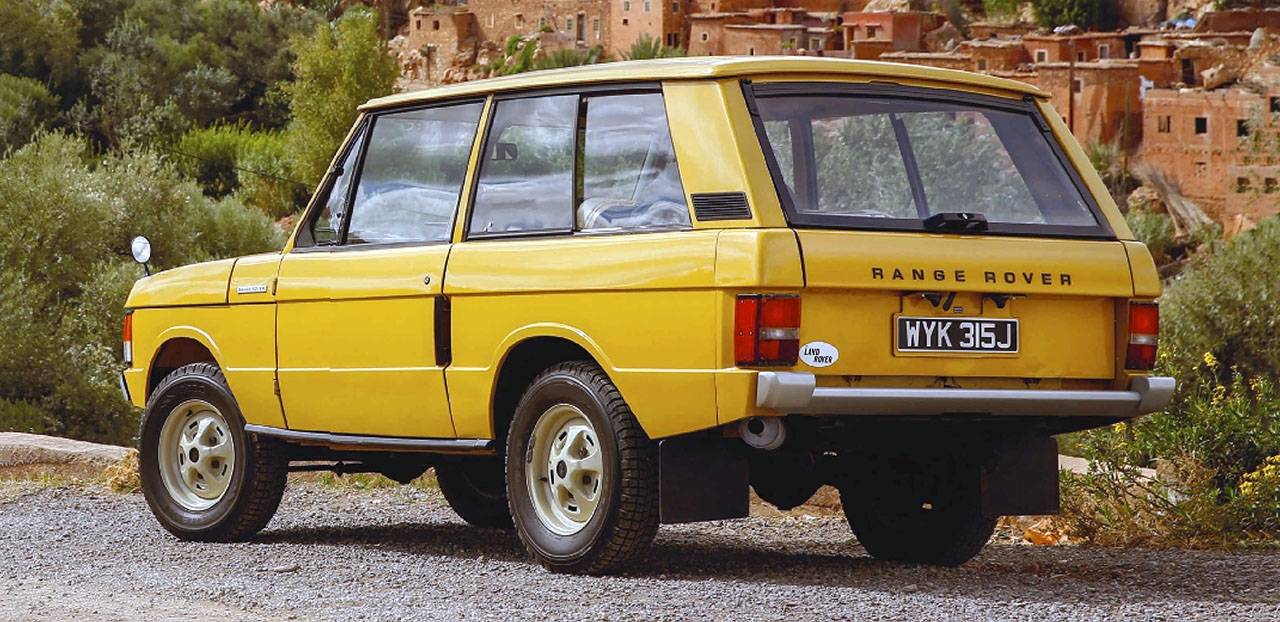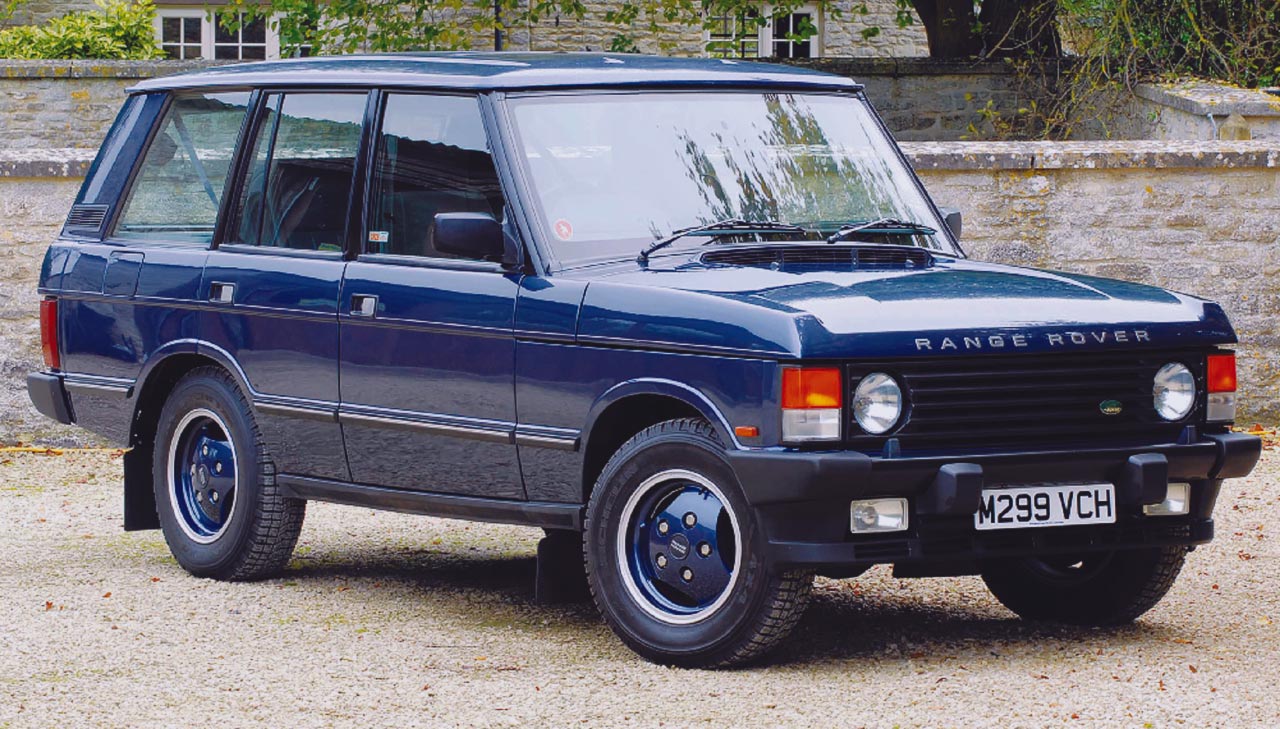
Marketplace classic Range Rover mind the gap £1850-£42,000+. From £1000 farmyard survivor to £40k collector’s car. Land Rover’s classic all-wheel drive SUV instantly created a niche market the latest version of this top drawer off roader still dominates today. Words: Iain Wakefield.
When Defender production finally ends at Land Rover’s Solihull plant in a few months’ time, it will leave the ground breaking Range Rover as the company’s longest-lived four by four by far. Despite this impressive achievement in what has developed into a very competitive market sector, the Defender will be sorely missed no matter how long the Range Rover remains in production. Over the years the slab-sided Land Rover has developed into a national institution and this willing workhorse has transported just about everything from sacks of potatoes to Popes and Royalty and has even gone to war.
In the early ‘50s Rover’s financial resources were severely limited but this didn’t stop the company wanting to produce a more refined version of its successful jack-of-all-trades and in 1951 the company unveiled what it called the Road Rover prototype. More a high-riding estate car than a true off roader, the Road Rover prototype was built on a shortened Rover P4 floorpan with rear-wheel drive and had ruggedly styled bodywork, a concept which predicted the current SUV market by several decades.
However, the company’s concern about the long-term success of the Land Rover selling in an expanding economy proved unfounded and sales of the agricultural-based four-by-four continued to remain strong. This resulted in the Road Rover project being side-lined until a much-improved MkII version broke cover in 1956. Closely resembling the P5, the revived Road Rover prototype had many car-like features, including independent front suspension and was seriously considered for production Once more the project was shunted into the sidings until the early ‘60s when the idea of Land Rover aggressively attacking the US market became a consideration. Management at Rover were convinced that a big growth area in the US was in the leisure off-road vehicle market. At the time there were only two US-built contenders with serious off-road capabilities, the Jeep Wrangler and Ford Bronco. If Rover developed the Road Rover into a viable product there was a massive opportunity waiting in North America but ironically the Range Rover didn’t officially cross the Atlantic until 1987.
However, back at Solihull the project to produce a luxury Land Rover gathered pace. Any serious contender would be based on the stalled Road Rover project but this concept would require a thorough overhaul and a four-by-four transmission to make it viable. Engineering chief Spen King suggested replacing the concept’s unforgiving leaf springs with a car-like coil suspension set up as the top selling US-produced Ford Bronco used coils up front. Subsequent research showed how coil suspension offered greater axle articulation and allowed the wheels to be in contact with the ground for more of the time than a leaf spring would allow.
To stop the rear end sagging under heavy loads, a Boge Hydromat self-levelling strut was added to the concept vehicle. Unfortunately Rover was stuck with using existing car axles fore and aft for its new luxury off roader while Japanese manufacturers like Toyota and Datsun were able to source heavyweight axles for its offroad prototypes from their truck divisions.
The solution to the relative lack of strength from these existing components was for Rover to make use of permanent four-wheel drive to spread the torque loadings between the two axles. It was also thought that using heavyweight axles would hinder on-road handling and performance. Code-named the 100-inch Station Wagon, the David Bache-styled ‘Birmabright’ aluminium bodied Range Rover was unveiled to a largely appreciative motoring press in June 1970 and at the time was the only V8 powered permanent four-wheel drive car on the market. The rest, as we say, is history…
VALUES
The classic Range Rover remained in production for 26 years and over the years the model’s basic design only received a number of mild updates to keep things fresh until the heavily revised P38a came on the scene in the mid- 1990s. This was a testament to the soundness of the original design, which featured a rugged box section chassis, a V8 powerplant and a manually lockable centre differential (the first few hundred Range Rover’s had a torque sensing automatic lock up but this was dropped due to reliability issues).
As launched, the Range Rover was only offered as a single model with a manual five-speed ‘box and was priced at £1998. Today, these early two-door Range Rovers are highly sought after and body-off professionally restored show queens complete with the now very rare ‘wash and wear’ heavy duty plastic faced seat coverings can cost up to £42,000 and beyond. However, these ludicrously high prices are thankfully an exception as £9,000-£15,000 can still bag a very nicely presented early ’70s Condition One 3528cc V8- powered classic Range Rover.
However, originality is key for many classic Range Rover owners and there are still some very tidy unmolested two-door examples around costing between £6000-£9500, while a budget of £3500-£12,000 will cover everything from a rough to a very presentable post-1981 four-door model. If the thought of running a V8-powered off roader makes your wallet tremble, a more economical 2392cc diesel engine was officially offered from 1987. Quite a few V8-powered Range Rovers were retro fitted with an oil burner, an unofficial conversion that will obviously affect the price and can quite often produce a bargain.
Basket case Range Rovers start at under £2000 but although the car’s aluminium bodywork may look sound, be warned as exterior panels are bolted to a steel frame and this structure can corrode badly. Any major repairs to the Range Rover’s frame and box section chassis usually requires the body to come off – not an easy undertaking. If originality is important, don’t forget to check the size of the V8 fitted to the example you’re looking at. This is important as the unit’s swept volume was increased from 3.5 litres to 3.9 litres in 1990 and again to 4.2-litres two years later on certain top of the range models.
BUYING THEM
With a wide variety of classic Range Rovers to choose from at prices to suit all pockets, you really do need to do your homework before taking the plunge and splashing out. By 1994 the Range Rover had moved upmarket and these later versions are a world away from the more basic early models. If you’ve never driven a Range Rover before and fancy owning one, take time to get behind the wheel of several different versions to discover which one suits you best.
Pay particular attention to the vehicle’s nether regions before parting with any cash. The Range Rover really is a ‘go anywhere’ vehicle, so under body damage may go unnoticed and can be expensive to put right. Automatic transmission became available on the Classic Range Rover from 1981 and the ZF four-speed box is well matched to the refined character of these cars as well as being able to cope with any on- and off-road use these vehicles often have to endure. The model of choice for many prospective first time classic Range Rover owners will probably be a late air-suspended Vogue SE. Despite this model’s luxurious pretentions, it’s still a very capable contender when it comes to off road mud plugging. Having said that, the simplicity and rugged nature of the earlier two-door variants has a certain charm too, and spare parts for all models are reasonably plentiful as are specialist repairers.
WHAT TO WATCH OUT FOR
Unfortunately many of these luxury 4x4s have been run on a shoestring for too long and can rust away unseen if basic body checks have been ignored. V8 powered Range Rovers can be thirsty beasts (many may been converted to run on cheaper LPG) but these vehicles will go almost anywhere whatever the power and are great fun to own. When buying a classic Range Rover, whether a petrol or diesel-powered example, be sure to check the following points:
ENGINE
Whatever the age of the car, heads and block on V8 engines can crack due to overheating. So check the cooling system carefully and look for any signs of coolant staining around the engine bay. Cylinder bores have been known to crack on 3.9 and 4.2-litre V8s but damaged liners can be replaced with ‘top-hat’ items, although this will require a major engine stripdown. Ignoring oil changes, or using the wrong grade of lubrication will kill a Rover V8, as sludge will quickly form in the oilways. The oil pressure valve can stick too, giving low readings and on later cars fuel injection pumps, relays and distributors can all fail.
TRANSMISSION
If the vehicle has been used regularly as a tow car, check the condition of the drive train carefully as severe wear in the transmission (gearbox, transfer box, rear and front differentials) will show up as clunks. Lifting on and off the throttle during a road test will show up any wear, especially to the propshaft splines and the mainshaft on manual gearboxes. Auto boxes tend to be pretty bulletproof but take a look at the colour of the fluid – it should be clean and bright and if it smells burnt, walk away.
SUSPENSION, BRAKES & WHEELS
Check the condition of all the dampers and springs, as any worn items can cause excessive body roll and unpredictable handling. Worn radius arm bushes will produce steering wheel shake on rough surfaces, as will incorrect swivel pin loads. Later cars with air suspension require specialised diagnostic equipment to repair and there’s a risk of serious injury working on the system without any specialist knowledge. Replacement air bags for air suspension have come down in price although some specialists are able to offer a coil spring conversion. Check out the condition of all the brake calipers, discs and pads as well as all the fluid lines and flexible connections. A myriad of after market wheels has been fitted to the Range Rover over the years, making original rims scarce in some cases. It pays to source a set of original wheels to make your classic Range Rover look as it did when new as this can add extra value to the car too.
BODY & INTERIOR
A tidy-looking body can be hiding a seriously rotten frame and chassis, especially around the area over the rear axle. Check the body shell carefully for rot; take the carpets out if possible, or crawl underneath with a torch and look in all the corners for any tell tale signs of corrosion. Front bulkhead and rear floors can corrode badly as can the inner wheel arches. Another notable area for the tin worm to feast on a Range Rover is at the top and bottom edges of the split tailgate. Although a limited amount of new old stock trim is still available, it pays dividends to source a car with a mainly complete and undamaged interior if possible. Many early cars with those infamous plastic seat facings will by now have been fitted with replacement fabric or leather seats from a later model, another good bartering point if originality is key to your purchase.

The range topping Vogue offers a superb level of comfort and is just as capable of fording a swollen river and winding its way up a slippery quarry path as the original Land Rover.
“The Range Rover really is a go anywhere vehicle, so underbody damage may go unnoticed and can be expensive to put right”
SPECIFICATIONS
MODEL 1986 Vogue
ENGINE: 3528cc V8 (fuel injected)
POWER: 165bhp at 4750rpm
TORQUE: 207lbf.ft at 3200rpm
TOP SPEED: 106mph
0-60mph: 11.9 sec
LENGTH: 447cm
WEIGHT: 1972.2kg
ECONOMY: 15mpg





